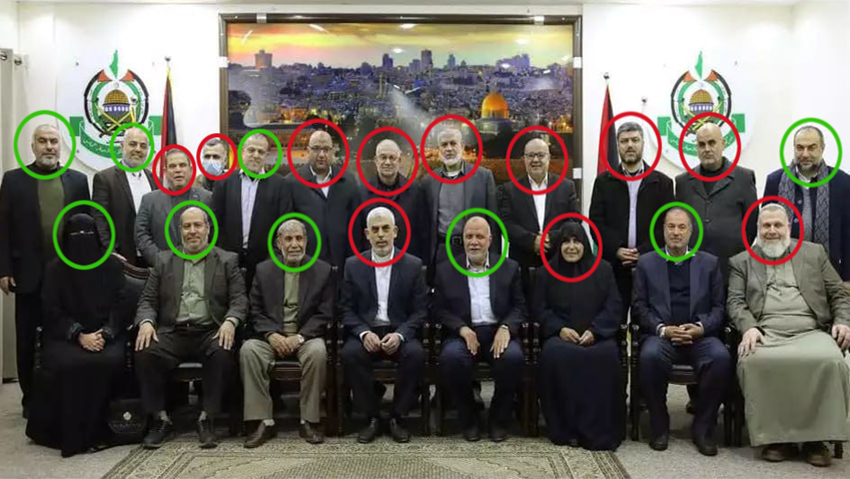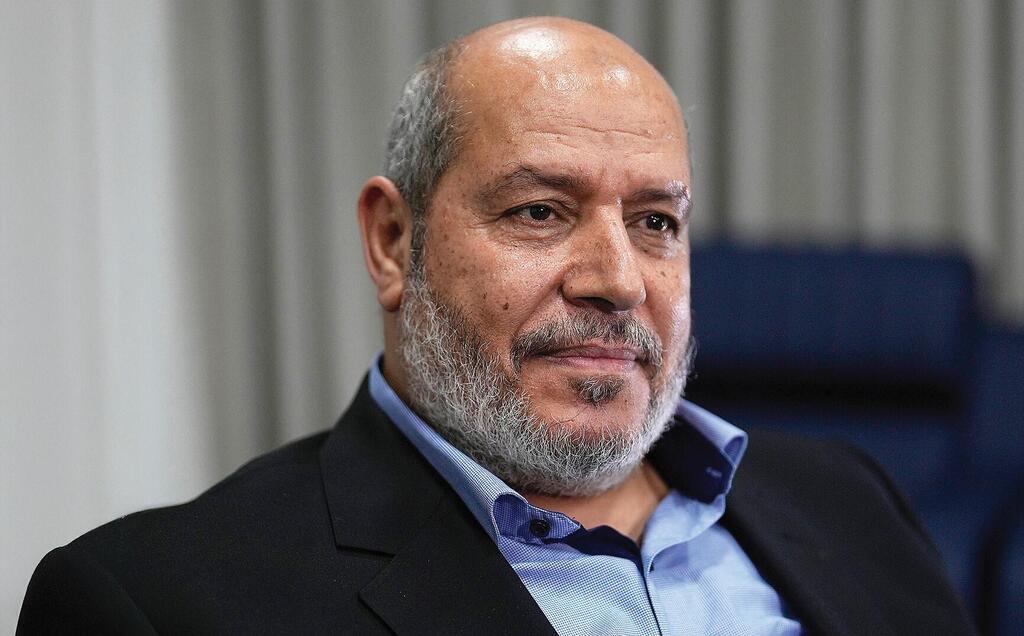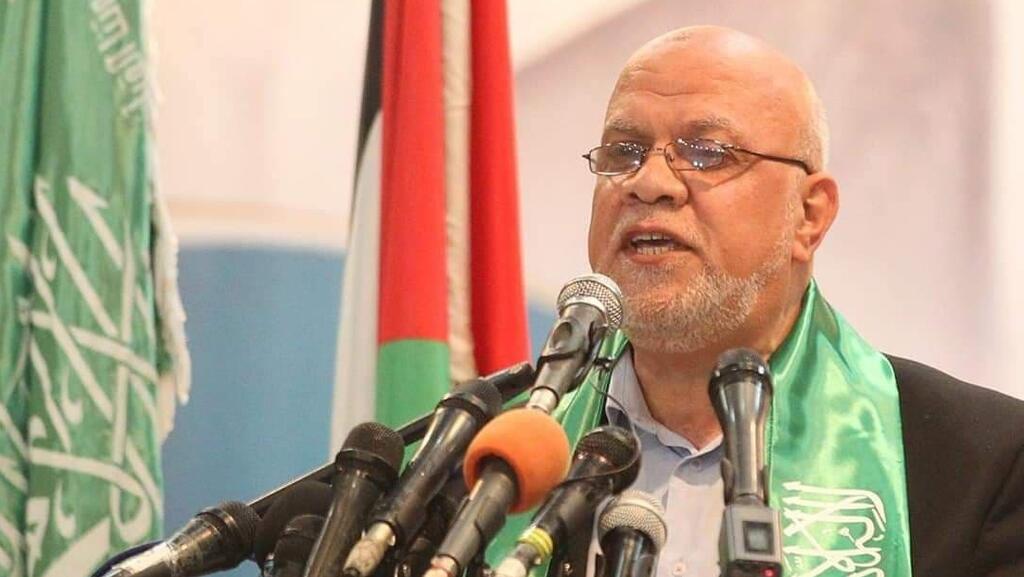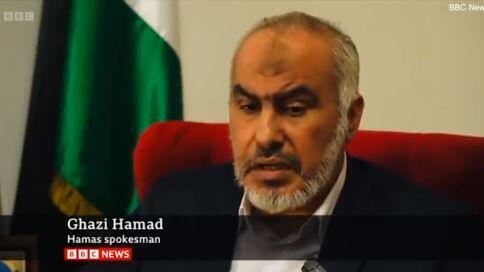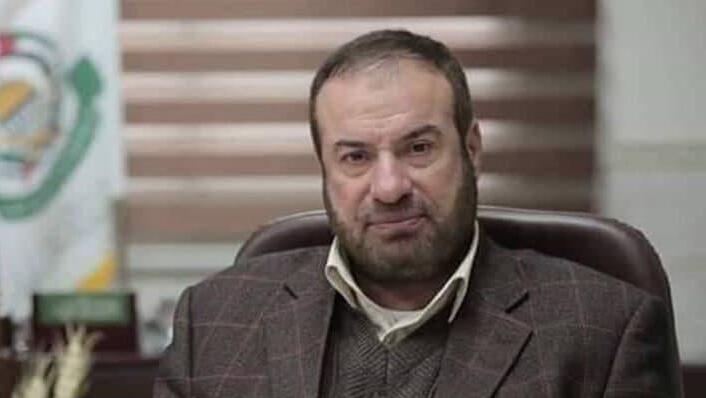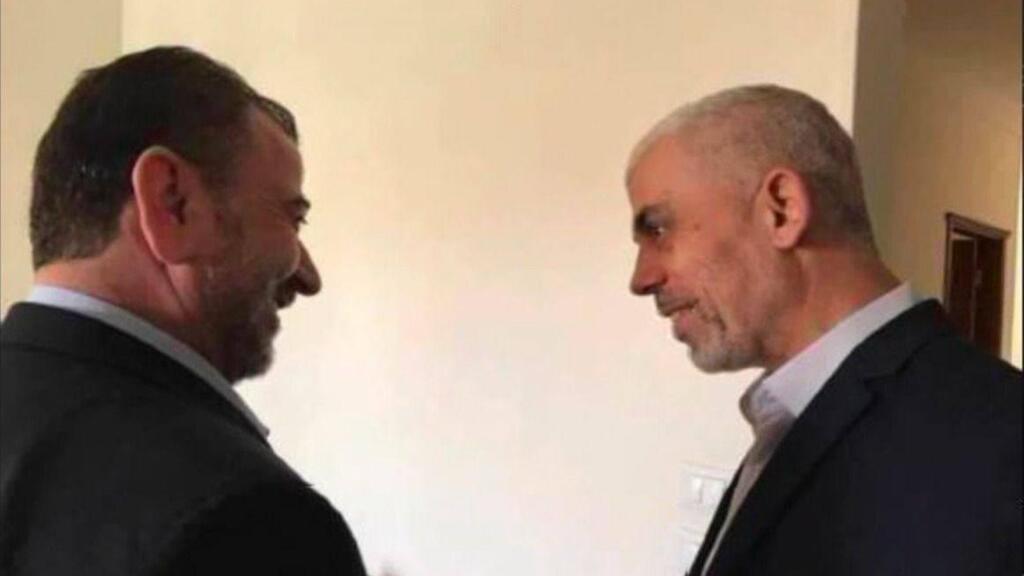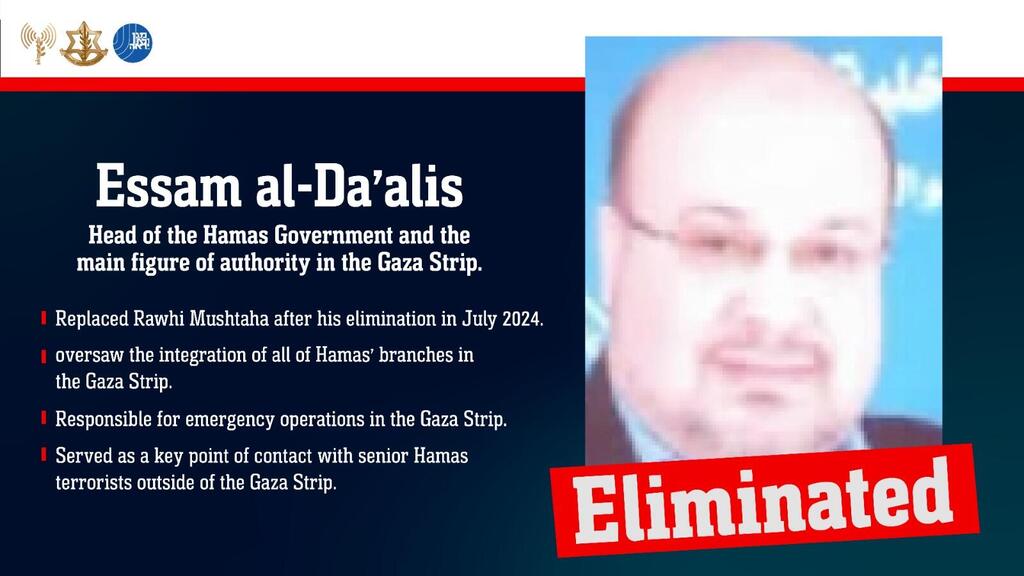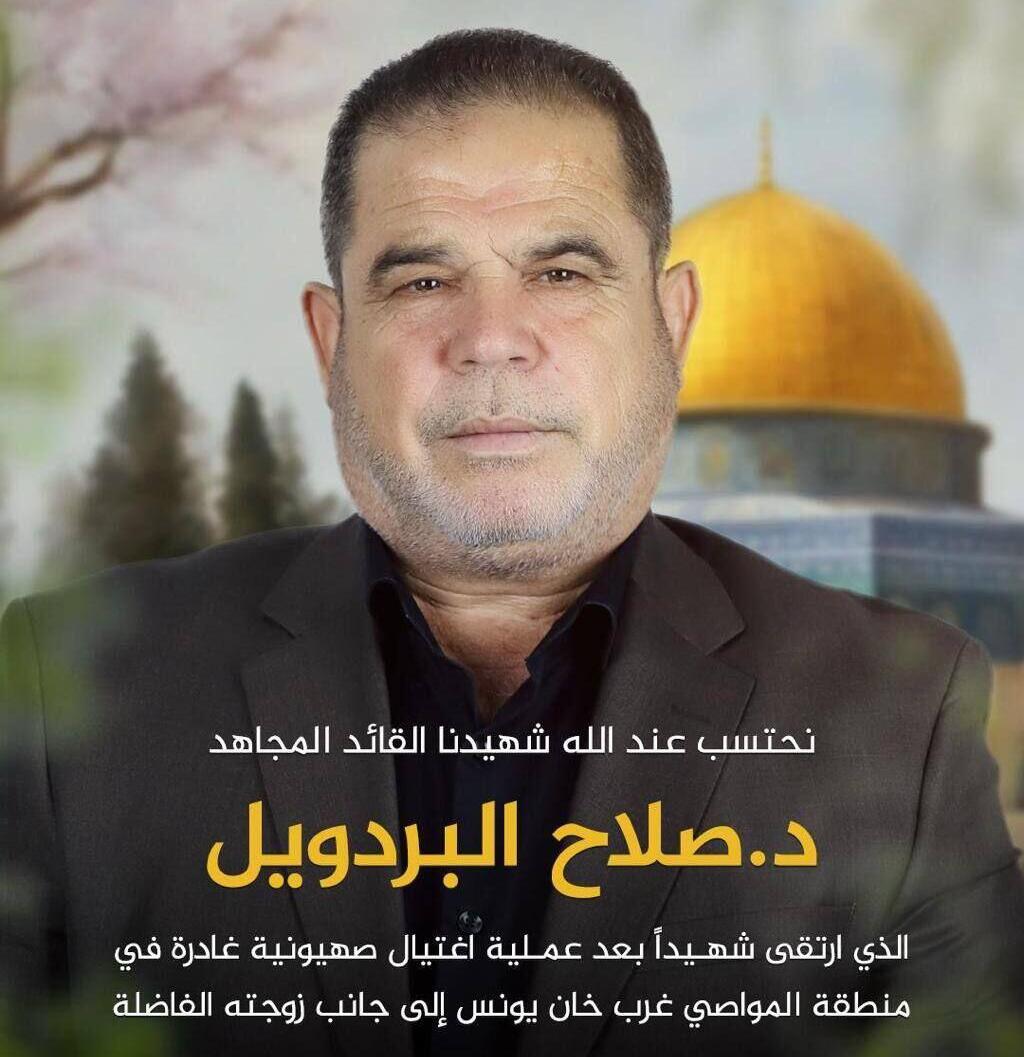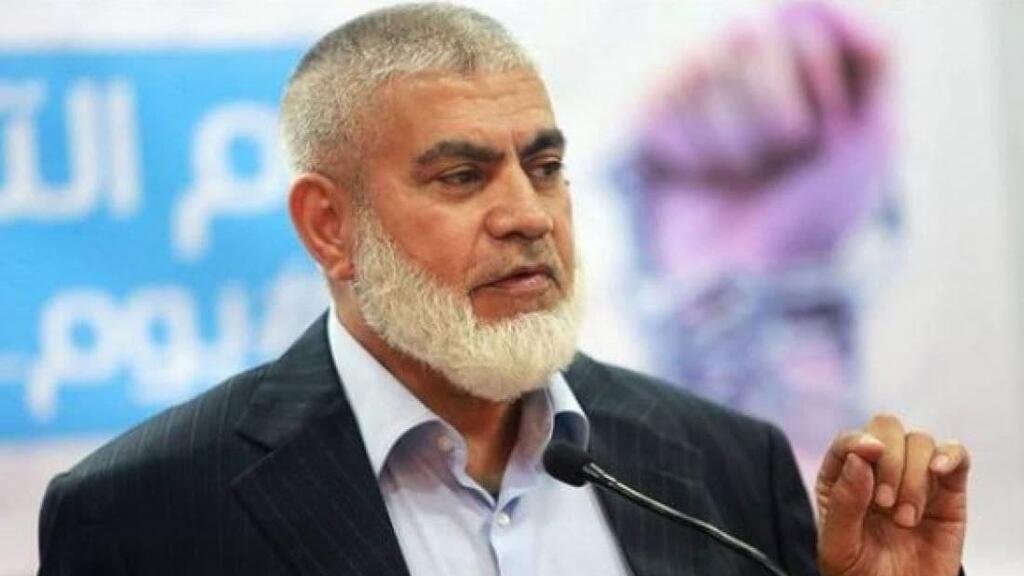Getting your Trinity Audio player ready...
Now, four years later, amid the ongoing war, the number of those still alive from that photo has dramatically decreased, and most of the survivors live abroad, with only a few remaining in the Gaza Strip.
In the March 2021 elections, 17 regular members from Gaza were elected to the political bureau of Hamas, along with three non-regular members. Among them were two women — one was elected as a regular member and one as a non-regular member. Other notable members, including Ismail Haniyeh and Saleh al-Arouri, were not part of the photo.
Khalil al-Hayya
Alive, living abroad – mainly in Qatar, but also traveling between countries. Al-Hayya is the de facto Hamas leader in Gaza, a member of the Hamas leadership council, and one of the negotiators for a ceasefire with Israel. His good relations with Yahya Sinwar helped him gain a dominant position in the organization, partly due to his strong ties with Sinwar's brother, Mohammad Sinwar — unlike other Hamas leaders abroad, who have weaker connections with Mohammad Sinwar. Al-Hayya left Gaza shortly before October 7.
Nizar Awadallah
Alive, living abroad – mainly in Qatar. Awadallah is also known for "making Sinwar sweat" during the 2021 Hamas leadership elections in Gaza, almost defeating him in the race for Hamas leadership. A founding member of Hamas, Awadallah was close to the organization's spiritual leader and founder, Ahmed Yassin. He was previously part of the negotiation team for the Shalit deal and, according to reports, currently holds a prominent role in negotiations between Israel and Hamas over a prisoner exchange.
Mahmoud al-Zahar
Alive, located in Gaza. A former foreign minister of Hamas and one of the organization's founders, he has held numerous positions and survived several assassination attempts. Known for his radical views on Israel and Holocaust denial, al-Zahar, 79, is reportedly suffering from dementia and is no longer significantly involved in decision-making within Hamas.
Ghazi Hamad
Alive, living abroad – mainly in Qatar. Hamad is seen as one of the more pragmatic senior Hamas leaders. He fled Gaza about two months before October 7. He previously served as Hamas's deputy foreign minister, the organization's spokesperson, and advisor to Ismail Haniyeh and Hamas military chief Ahmed Jabari, who was killed in 2012. Today, aside from being a member of the political bureau, he chairs the Gaza Energy Authority. After October 7, he vowed to continue Hamas’s massacres, stating that "Israel has no place on our land; this is a country we want to bring down."
Fathi Hamad
Alive, living abroad – likely in Turkey. Hamad is considered part of Hamas's more radical faction. He previously established a private militia for carrying out attacks and has frequently called on Palestinians in the West Bank to kill Israelis. He has also served as Hamas's interior minister. Following the massacre, Hammad criticized Mahmoud Abbas, saying, "The Palestinian people are preparing to establish a caliphate, with Jerusalem as its capital."
Suhail al-Hindi
Alive, living abroad – likely in Qatar or Turkey. Al-Hindi has been active in Hamas since its early days. He is known for his time as head of the UNRWA workers' committee in Gaza from 2012 to 2017, while also managing a boys' elementary school. He resigned from UNRWA in 2017 after being named to the political bureau, a move that caused controversy. Al-Hindi later held various positions within Hamas, including responsibility for the 2018 "Great March of Return" protests at the Gaza-Israel border.
Kamal Abu Awn
Alive, likely in Qatar. Formerly the secretary-general of Hamas’s political bureau in Gaza, he lost his son, daughter, and three grandchildren during the war. His home in Deir al-Balah was attacked during the war.
Maher Sabra
Alive, located in Gaza. A senior assistant to the Hamas political leadership, but not a full member of the political bureau.
Fatima Sharab
Alive, located in Gaza. She heads the women's section of Hamas. Sharab’s face has never been seen in public; she is always pictured wearing a veil. Known for her activism regarding Palestinian female prisoners in Israeli jails, she holds views aligned with the Muslim Brotherhood.
Yahya Sinwar
Eliminated. Former Hamas leader, killed in combat with IDF forces in Rafah. He became the leader of Hamas after Ismail Haniyeh's assassination in Tehran. Sinwar was one of the masterminds of the October 7 massacre and led Hamas in Gaza since 2017.
Essam al-Da'alis
Eliminated. Former prime minister of Hamas in Gaza. Dalis was killed in an airstrike on the first day of renewed fighting in Gaza. He was close to Hamas’s senior leadership, including Ismail Haniyeh, and was one of the key figures in Hamas’s civilian administration. During the war, Dalis continued to move around Gaza, sometimes on foot, managing government affairs despite ongoing Israeli attacks.
Ismail Barhoum
Eliminated. Head of Hamas’ institutions and finances, Barhoum replaced Issam Dalis as Hamas prime minister, holding the position for five days. He was killed in an airstrike at the Nasser Hospital in Khan Yunis. Prior to his appointment, Barhoum was responsible for managing Hamas’s finances, including funneling funds to the group's military wing.
Salah al-Bardawil
Eliminated. According to the IDF, Bardawil was responsible for Hamas’s planning and development office and led the strategic and military planning for the organization in Gaza. He was killed in an airstrike on his tent. Bardawil was also a member of the Palestinian Legislative Council and served as an editor for Hamas’ newspaper "Al-Risalah."
Jawad Abu Shamala
Eliminated. Hamas's economy minister, responsible for managing the group’s finances both in Gaza and abroad. He was killed in an airstrike days after the massacre. According to the IDF, Abu Shamala also held security positions within Hamas.
Zakaria Abu Maamar
Eliminated. Head of Hamas’s national relations office within the political bureau, he was killed on the same day as Jawad Abu Shamala in Gaza. His role involved coordinating internal Hamas relations and liaising with various organizations.
Osama Mazini
Eliminated. Chairman of Hamas’ Shura Council in Gaza and former education minister in Hamas’ government. He was involved in managing the Gilad Shalit affair. Al-Mazini was killed in an Israeli airstrike on his house in the early days of the war.
Jamila Abdallah Taha al-Shanti
Eliminated. The first woman in Hamas’s political bureau, al-Shanti was the widow of Abdel Aziz Rantisi, one of Hamas’s founders, who was killed in an Israeli airstrike in 2004 shortly after replacing Ahmed Yassin as Hamas leader.
Sameh al-Siraj
Eliminated. According to The Times, al-Siraj led a secret intelligence and cyber unit operated by Hamas in Istanbul. He was known to be close to Yehya Sinwar. The IDF reports that he held the security portfolio within Hamas’s political bureau for a time and held various security roles.
Get the Ynetnews app on your smartphone: Google Play: https://bit.ly/4eJ37pE | Apple App Store: https://bit.ly/3ZL7iNv
Rawhi Mushtaha
Eliminated. Head of Hamas' government in Gaza and considered to be Yahya Sinwar's right-hand man. Mushtaha was killed in an Israeli airstrike during the war. He is identified with Hamas’ radical faction and co-founded the organization’s internal security apparatus with Sinwar. Mushtaha also served time in Israeli prison with Sinwar.
Marwan Issa
Eliminated. Deputy to Muhammad Deif, often considered Hamas’s “military chief” for years. A founding member of Hamas, Issa was known as a shadowy figure and, for years, no clear images of him existed. In his official photo from the political bureau, he is seen wearing a face mask. Issa was killed in an Israeli airstrike in the Nuseirat refugee camp during the war.
Other senior figures who were eliminated
In addition to the 20 figures seen in the 2021 photo of Hamas’ political bureau in Gaza, other senior Hamas leaders have been killed during the war. Notably, the organization’s leader Ismail Haniyeh, who was assassinated in Tehran in July 2024, and Saleh al-Arouri, who was killed in a 2024 Israeli airstrike in Beirut. Al-Arouri served as Haniyeh’s deputy.
Furthermore, following the end of the ceasefire in Gaza last week, two additional senior local Hamas figures, who were former members of the political bureau, were killed: Muhammad al-Jamasi, who headed Hamas's administrative body in southern Gaza and served as chair of the movement's emergency committee; and Yasir Herev, who handled security for the political bureau and led Hamas’s development office. Herev was also known to be close to Yahya Sinwar.




